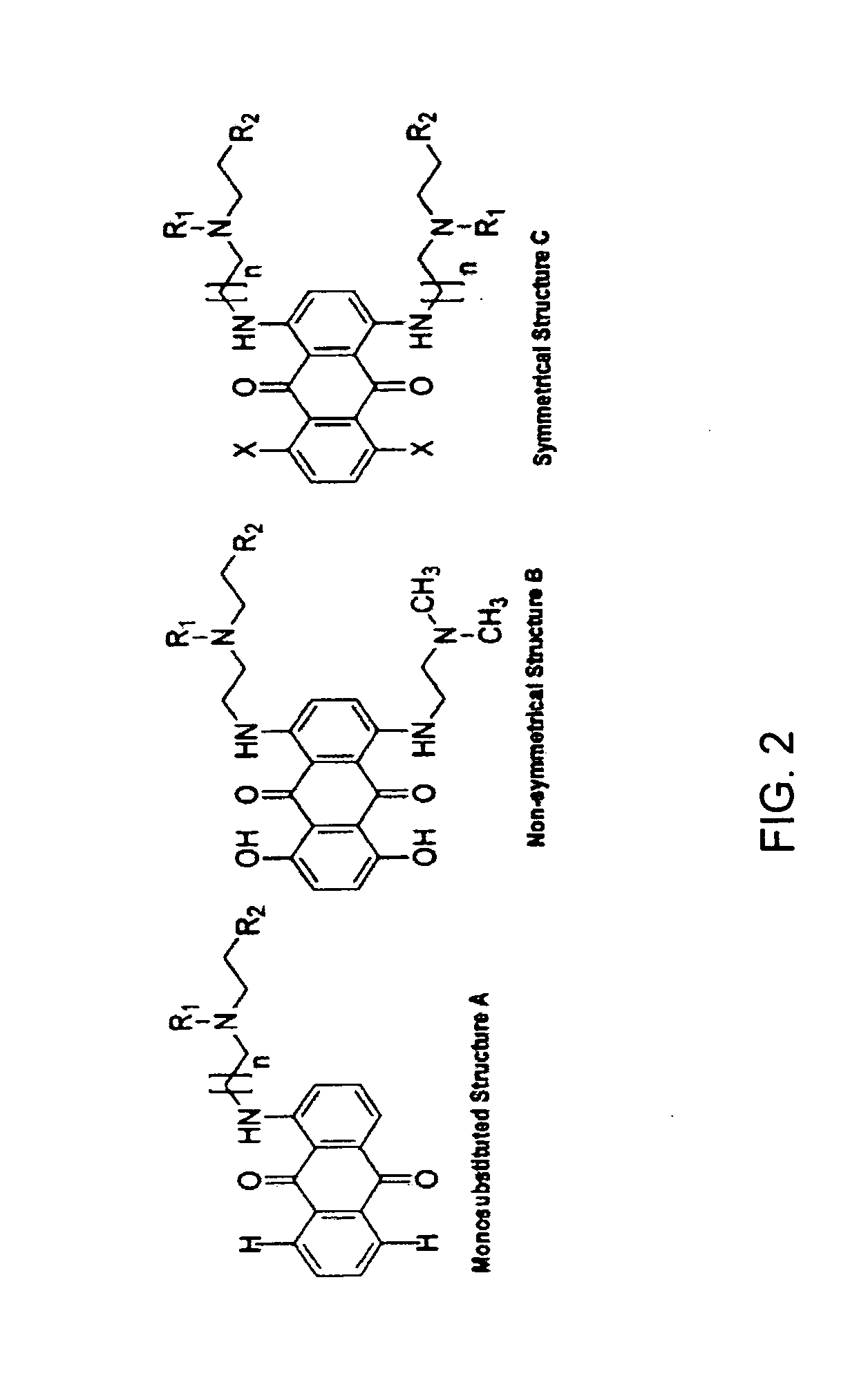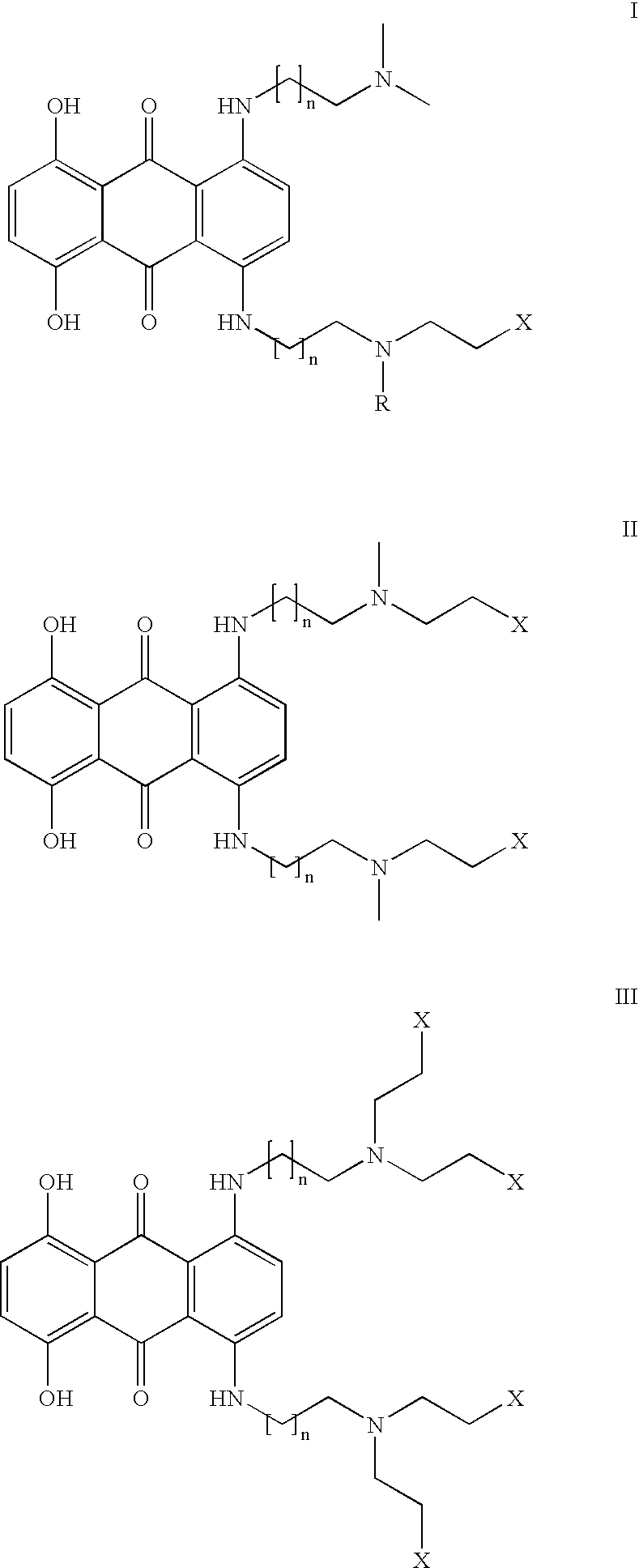Potent cytotoxicity and inhibition of pan-cell cycle progression by an alkylating anthraquinone
a technology of alkylating anthraquinone and pan-cell cycle, which is applied in the direction of biocide, drug composition, animal husbandry, etc., can solve the problems of chromosomal breakage, drug resistance, and damage to the dna
- Summary
- Abstract
- Description
- Claims
- Application Information
AI Technical Summary
Problems solved by technology
Method used
Image
Examples
example 1
Synthesis of Chloroethylaminoanthraquinones
General Method for Synthesis of Anthraquinones
[0028] 1-monosubstituted hydroxyethylamino-anthraquinones (HAQs) were prepared by the displacement of chloride from 1-chloroanthraquinone with an aminoalkylamino side chain in a polar solvent such as 2-methoxyethanol. The 1,4-disubstituted HAQs were synthesized as described in Pors et al. (J. Med. Chem., 47:1856-1859 (2004)) using previously described methods (Johnson et al., Cancer Treat. Rep., 63, 425-439 (1979); Murdock et al., J. Med. Chem. 1979, 22, 51-60) by the condensation of either leucoquinizarin or 5,8-dihydroxyleucoquinizarine (5,8,9,10-tetrahydroxyanthra-cene-1,4-dione) with an excess amount of N-alkyl-N-droxyalkylaminoalkylamine, which was synthesized as described in Aspinall (J. Am. Chem. Soc. 63: 852-853 (1948)) and Preston et al. (J. Med. Chem. 7:471-482 (1964). The 1,4-disubstituted HAQs were typically isolated at a yield between 20 and 50%, depending on the purity of the si...
example 2
Cell Cycle Events
In Vitro Studies
[0034] Cytotoxicity (IC50) was determined using a 96-well plate-based 3-(4,5-dimethylthiazol-2-yl)-2,5-diphenyltetrazolium bromide assay with a 24-h drug exposure period and a 3-day growth period. Cells were maintained in RPMI 1640 containing glutamine (2 mM) and FCS (10%).
U-2 OS Cell line
[0035] The U2 OS cells were stably transfected with a Green Fluorescent Protein tagged Cyclin B1 reporter and maintained at 37° C. and 5% CO2 in McCoys 5A modified medium (Sigma) supplemented with 2 mM glutamine, 100 units / ml penicillin, 100 μg / ml streptomycin, 10% fetal calf serum and 1000 μg / ml geneticin. Appropriate dilutions were added to the wells to obtain treatment regimes of 0, 10 and 100 nM of the experimental compound.
Timelapse Experimental Set-Up
[0036] The cells were plated in a 6 well plate (density ˜15-20%). Each experiment consisted of the paired drug treatment at the appropriate dose added to the cells and the plate was placed on a stage of a...
example 3
In Vitro Activity of the Compound of Formula IV
[0041] To identify the activity of the compound of formula IV in additional cell lines, an NCI human cell line panel was screened for sensitivity to the compound. Cytotoxicity was evaluated for chloroethylaminoanthraquinone compounds synthesized as described in EXAMPLE 1, using an in vitro cell based assay as described in Pors et al., Mol. Cancer Ther., 2:607-610 (2003).
[0042] Human tumor cell lines from the NCI human cell line panel (Table 2) were tested in the assay.
TABLE 2Cytotoxicity of Compound IV in Human Cell LinesType ofCell LineCell LineLog IC50IC50IC50 nM1LeukRPMI 8226−8 −8*2NSCLCA549 / ATCC−7.572.6915 × 10−8273EKVX−6.127.5858 × 10−7759 4NCI-H226−7.275.3703 × 10−8545NCI-H322M−6.532.9512 × 10−7295 6NCI-H460−8 −8*7ColonHCT-116−8 −8*8HCT-15−8 −8*9HT-29−8 −8*10KM 12−6.861.3804 × 10−7138 11CNSSF 268−8 −8*12SF 539−8 −8*13U251−7.721.9055 × 10−81914MelanomaLOX IMVI−8 −8*15SK MEL 5−7.157.0795 × 10−87116UACC-257−5.731....
PUM
| Property | Measurement | Unit |
|---|---|---|
| generation time | aaaaa | aaaaa |
| generation time | aaaaa | aaaaa |
| drug resistance | aaaaa | aaaaa |
Abstract
Description
Claims
Application Information
 Login to View More
Login to View More - R&D
- Intellectual Property
- Life Sciences
- Materials
- Tech Scout
- Unparalleled Data Quality
- Higher Quality Content
- 60% Fewer Hallucinations
Browse by: Latest US Patents, China's latest patents, Technical Efficacy Thesaurus, Application Domain, Technology Topic, Popular Technical Reports.
© 2025 PatSnap. All rights reserved.Legal|Privacy policy|Modern Slavery Act Transparency Statement|Sitemap|About US| Contact US: help@patsnap.com



